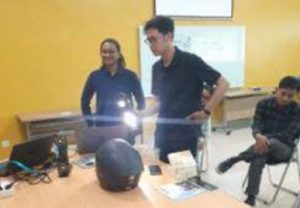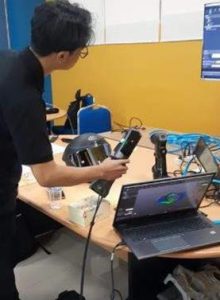A 3D scanner is a device used to scan objects in three dimensions and produce digital data about their shape and size. This tool operates using various technologies such as laser, structured light, or photogrammetry to record information about an object’s surface and convert it into an accurate three-dimensional model in software such as CAD, such as Solidworks and similar programs. The benefits of a 3D scanner in the reverse engineering process are significant. Firstly, it allows obtaining accurate digital data about the shape and size of an object, even if original drawings or design information are not available.
 By utilizing the data obtained from a 3D scanner, the reverse engineering process becomes easier and more efficient. Additionally, a 3D scanner enables the reconstruction of complex details of the object to be reverse engineered, including small features that are difficult to measure manually. This helps improve the accuracy and quality of the products produced in the reverse engineering process. Furthermore, the use of a 3D scanner can save time and costs in the development of new products or the improvement of existing ones, as it enables quick and accurate measurements and analysis.
By utilizing the data obtained from a 3D scanner, the reverse engineering process becomes easier and more efficient. Additionally, a 3D scanner enables the reconstruction of complex details of the object to be reverse engineered, including small features that are difficult to measure manually. This helps improve the accuracy and quality of the products produced in the reverse engineering process. Furthermore, the use of a 3D scanner can save time and costs in the development of new products or the improvement of existing ones, as it enables quick and accurate measurements and analysis.
The Mechanical Design Engineering Applied Bachelor’s Program at the Vocational School of Diponegoro University has an interesting initiative with the procurement of a 3D scanner and conducting reverse engineering training for students. This initiative demonstrates the program’s commitment to introducing cutting-edge technology and preparing students with relevant skills in the industry, especially in the discipline of mechanical design engineering. With the presence of a 3D scanner, students have the opportunity to learn and master the important 3D scanning technology in the reverse engineering process. The training provided gives students the opportunity to understand the concepts and techniques of reverse engineering and apply them directly using the 3D scanner. Through this combination, students can develop practical skills in reconstructing and modifying mechanical components, which are valuable skills in the industrial world.
initiative with the procurement of a 3D scanner and conducting reverse engineering training for students. This initiative demonstrates the program’s commitment to introducing cutting-edge technology and preparing students with relevant skills in the industry, especially in the discipline of mechanical design engineering. With the presence of a 3D scanner, students have the opportunity to learn and master the important 3D scanning technology in the reverse engineering process. The training provided gives students the opportunity to understand the concepts and techniques of reverse engineering and apply them directly using the 3D scanner. Through this combination, students can develop practical skills in reconstructing and modifying mechanical components, which are valuable skills in the industrial world.

